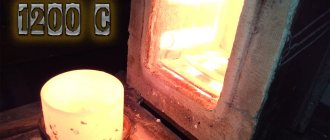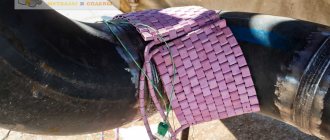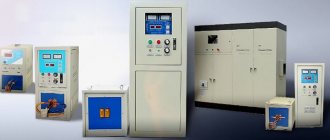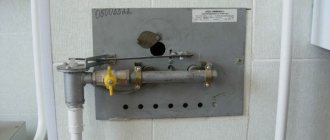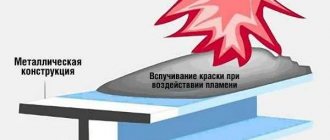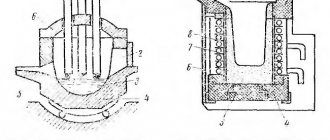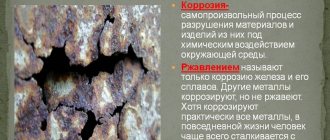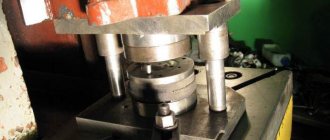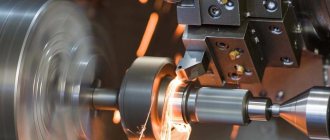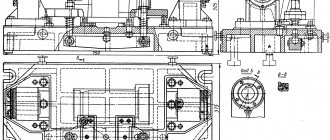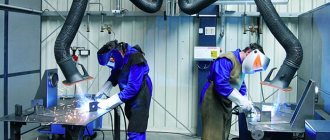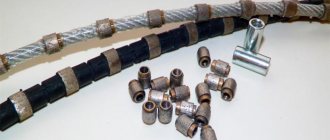Methods of heat treatment of materials
Equipment for heat treatment of steel, cast iron, aluminum and other metals is intended for heating and subsequent cooling of raw materials. During these processes, its structure and properties change, while the chemical composition remains original. The main types of thermal effects are:
- Annealing . Metals heat up and then cool down. The temperature decrease occurs in the oven at a slow pace.
- Hardening . Processing occurs when the degrees rise to a critical level, followed by rapid cooling.
- Vacation . Carried out after hardening, it is designed to reduce brittleness and stress in steel, and increase its flexibility.
- Normalization . A process similar to annealing. The difference is that the metals are cooled in the open air.
The process of processing metal blanks in an industrial furnace
Types of chamber furnaces by hearth type
In large industries, chamber furnaces with a sliding hearth are in demand, making the heat treatment process extremely effective. They provide fast and convenient loading and unloading. Retractable hearths reduce physical stress when servicing equipment. To unload such devices outside the furnace, forklifts are used.
A chamber furnace with a roll-out hearth allows you to avoid equipment downtime, since you can load several slabs. Thus, the efficiency level increases by 1.9-2.5 times, while energy consumption is reduced to 25%.
Chamber electric furnace SNOL 3500/1200 with sliding hearth
Unlike previous designs, a chamber furnace with a fixed hearth has minimal heat loss when metal blanks are placed on the stove. Loading and unloading is carried out using mechanical devices. If we consider compact electric ovens with a ceramic chamber, they do not need to use roll-out or pull-out trays.
Chamber electric furnace with loading at different levels on removable shelves
Furnace hearths are made of heat-resistant materials such as silicon carbide, cast iron, steel or ceramics. The plates can withstand high temperature and mechanical loads
Types of heat treatment equipment
Since heat treatment furnaces and equipment are designed for different purposes, they differ in:
- Loading hole location . Horizontal, vertical, tubular, under a hood, in the form of a well.
- Additional features . Work in vacuum, gas environment, etc.
- Temperature capabilities . Low, medium or high temperature.
This is how a vertical oven is loaded
Depending on the fuel used, equipment for heat treatment of metals and other materials can be divided into the following types:
Gas ovens
In order to reduce heat loss, chamber heat treatment furnaces are well insulated and made of refractory materials. The hearths of such devices are made of cast iron, steel, and can also be ceramic or silicon.
Thanks to the ability to set precise settings, the furnace can operate over a wide temperature range - from slight heating to complete melting of the material
Thermal chamber gas furnace at a new facility, ready for operation
Muffle structures
Muffle equipment for heat treatment, which can be purchased at, is distinguished by its special chamber capabilities. It serves several purposes simultaneously:
- Maintains the desired temperature.
- Provides even heating.
- Protects samples from contact with combustion products, air and fumes.
Materials for the manufacture of muffle furnaces can be ceramics, clay, mineral wool, asbestos, brick and others.
SNOL oven with a ceramic chamber and the chamber itself
Electric furnaces
Electrical equipment for the heat treatment of metals has the greatest variety of models and varieties. According to the method of influencing the material and converting energy, they are divided into:
- Induction . The crucible of such industrial furnaces includes metal parts. Heating occurs through the release of energy when an electric current passes through them. Mainly used for making alloys.
- Arc . Operate with direct or alternating current. Metals are processed in a vacuum or gas environment. The devices must be equipped with a cooling system. They are an option for inexpensive equipment for heat treatment, as they consume a small amount of electricity.
- Infrared . The heat source in such devices emits infrared radiation, which promotes rapid and uniform heating of parts.
Brand new electric oven with thermofiber chamber
Classification of chamber thermal furnaces
For extremely precise operation, thermal chamber furnaces are equipped with hardening sections, microprocessor controllers and programmers. The devices automate equipment maintenance performed according to a given program. A properly selected oven with a fiber chamber not only speeds up the heating process, but also increases its efficiency.
Types of chamber furnaces can be divided into:
- Design features . The chambers are vertical, pit, bell-shaped, well-shaped.
- Energy source . The most popular are electric models; gas and oil models are also used.
- Like a pod . The choice depends on the volume of materials processed. There are retractable, roll-out and fixed slabs.
If we consider chamber firing furnaces in more detail, we can distinguish several main groups. They differ not only in purpose, but also in the volume of working boxes. There is also a wide choice of manufacturing materials, boundary temperatures, thermal gradients, types of convection and other factors.
Chamber firing furnace SNOL 7.2/1300 L
Design of heat treatment equipment
Despite the differences in the way heat treatment equipment operates, they all have a similar design, which includes:
- Loading hole . A bucket, conveyor, winch, etc. can be used to load raw materials.
- Unloading block . It is a chamber where finished products are dosed.
- Smoke ducts . The latest models of appliances are equipped with automatic chimneys located on the back of the stoves.
- Camera . The main structural element into which the starting material is embedded.
Since the range of machines for processing metals, ceramics, porcelain, etc. is constantly updated, contact a specialist to correctly select the appropriate device! We will certainly help you choose the optimal equipment for your goals.
Chamber furnaces SNOL – SNO – Technical characteristics
The SNO chamber furnace is assembled from a frame welded from a steel profile. The frame is covered with sheet steel. Inside it is a layer of thermal insulation, which avoids heat loss and ensures continuous operation. This layer is a lining to enhance mechanical strength and durability of use. Chamber resistance furnaces SNOL have the following characteristics:
- Furnaces are developed based on the design features of the customer;
- Heating from three sides at once (side walls and underneath) for tempering furnaces;
- Heating from five sides at once (side walls, back wall, door and underneath) for hardening furnaces;
- Uniform exposure to temperature in the chamber ± 5°C.
Chamber electric furnace SNA-6,5.6,5.7/4
Chamber electric furnace SNO-8.16.5/12.5
Chamber electric furnace SNO-6.12.4/11
|
Chamber electric furnace SNO-5.7.5/7
Chamber electric furnace SNO-4.8.3/11-02
|
Chamber electric furnace SNO-8.10.4/7
Chamber electric furnace SNO-8.10.4/12
|
Chamber kiln for firing ceramics
A chamber kiln for firing ceramics, porcelain or clay is used in educational and art centers, in pottery workshops and souvenir manufacturing enterprises. The type of equipment is selected depending on the needs and volume of production. Considering these factors, there may be different:
- Design features.
- Working chamber size.
- Temperature range.
Ovens are equipped with vertical or front loading. Pods can be either fixed or retractable. To ensure uniform temperature, fans are installed.
Electric furnace SNOL 80/1100 for firing ceramics and porcelain
The chambers are made of fire-resistant and heat-insulating materials. Tubular or wire high-resistance parts are used for heating elements
Additional mechanisms for providing heat treatment furnaces
Some types of production produce rolled products. This includes profiles, pipes, welded structures, etc. To give the required shape before or before the part enters the thermal oven, special temperature presses are used to straighten surfaces. There are dynamic impact devices and static units. The first option involves creating the desired geometry using pulsed impacts with the surface of a press for thick-walled or rolled pipes. Static presses make smooth and slow straightening of thin-walled pipes and profiles of various shapes. The editing procedure itself takes little time and includes the geometry control stage, the editing itself and final quality control. When highly critical products are processed on such a device, individual low-temperature tempering is used to relieve metal stress, carried out at a temperature of about 200 degrees.
After the product has undergone heat treatment, it must be tested to ensure the required quality. For these purposes, a stationary hardness tester is used, which provides operational control directly at the production site. If the object being processed has large dimensions that do not allow readings to be taken with a standard device, it is possible to use portable hardness testers, which differ in the direct method of measurement and the indirect option of reading mechanical properties. Some industries often use coercimeters, the main purpose of which is to control the chemical-thermal hardness, depth of the formed layer and other parameters on sample parts. In parallel with this device, portable microscopes with a dimensional grid printed on the lens can be used.
Metal hardening
Heating of metal products is carried out in a special furnace, in an environment of protective gases. The heating temperature should be 50 C higher than the temperature threshold for changing the crystal lattice. For steel, this temperature is 768 C. After this, the heated metal must be cooled sharply. A quenching bath is used for this purpose.
When the metal is heated, the crystal lattice transforms from the phase of ferrite and cementite to austenite . Having reached the austenitic transformation phase, the product acquires a fine-grained structure, which makes the metal of extremely high quality. Next, the heated metal must be quickly cooled.
Rapid cooling is necessary to obtain the so-called nonequilibrium phase (austenite turns into martensite). This allows the fine-grained structure of the metal to be captured as completely as possible.
The hardening process for different grades of steel, as well as non-ferrous metals and alloys, will vary. To achieve the optimal result from hardening, it is necessary to carry out heat treatment in full accordance with the route map.
The hardening process must be completely controlled. The thermist needs to take care that the temperature conditions exactly correspond to the values specified in the route map.
To take full control of the heat treatment of metal products, it is necessary to use a hardening bath, which is equipped with all the equipment necessary for this. How to choose a hardening bath based on design.
Chamber furnaces for heat treatment of metal surfaces
Chamber furnaces for heat treatment of metal are made of high-strength materials. Most often, the inside of the work box is protected with thermal fiber and fire-resistant bricks. Among the features of the models are:
- Operating temperature range from 50 to 1300°C.
- Heaters of open or closed type.
- Devices for removing excess moisture.
A chamber furnace for heat treatment may have reinforced walls and hearths. Additional equipment with shelves and baking trays, racks, hangers, rods and other devices is also allowed. To make it easier to monitor work processes, the door has a viewing window.
Industrial chamber electric furnace SNOL 144/1250 MS for metal processing
Types of chamber furnaces for solder reflow
A chamber solder reflow furnace manufactured by SNOL is necessary for soldering circuit boards that contain components for surface fastenings. Equipment is distinguished by the following features:
- Construction type.
- Warm-up method.
- Number of heating zones.
- Number of cooling sections.
When choosing equipment of this type, please note that it differs in the intensity and speed of heating. Just like chamber drying cabinets, they can have low, medium and high productivity.
Chamber electric furnace SNOL 4/1300 for solder reflow
